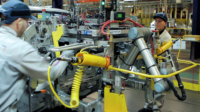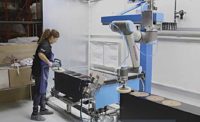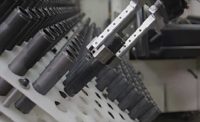LONDON—During the past decade, collaborative robots have taken the manufacturing world by storm. The small, dexterous industrial robotic arms have opened up new opportunities for human-machine interaction without the need for complex programming or external safety infrastructure.
“In reality, the value of current collaborative robotics is somewhat more modest,” claims Rian Whitton, senior analyst at ABI Research. “Collaborative systems are not a revolution in robotics, but are instead a parallel technology that has some advantages over traditional industrial arms, and some disadvantages.
“Since 2008, collaborative robots have been adopted at a feverish rate,” says Whitton, who recently authored a report on the topic. “While there are significant limitations on current technology, the benefits of a more flexible and less expensive industrial-grade robot arm provide a great option for manufacturers that are struggling to invest high amounts of capital into comprehensive automation solutions.
“While pure cobot providers have been flourishing, the industrial robot mainstays have yet to really capitalize on this opportunity, with their various offerings being either too expensive or too complicated to operate to gain mass adoption,” explains Whitton.
ABI Research predicts that collaborative robots will generate $6 billion in annual revenue by 2027, with one-third that investment dedicated to automotive assembly applications. According to Whitton, collaborative systems will increasingly become indistinguishable from conventional industrial robotic arms, potentially opening the market to a much higher valuation.
“However, [many] challenges remain for the industry,” warns Whitton. “There are well over 50 major collaborative robot providers, and in this highly saturated space, the lack of differentiation between products is a significant problem.
“Some [suppliers] emphasize the agility [that a] seventh axis provides their arm, [while] some focus on the intuitive controller and some focus on developing cobots with higher payloads,” says Whitton. “But, overall, hardware innovation has been limited and the current ecosystem is far too large to avoid consolidation over the next few years.
“The most impressive provider in this space is currently Universal Robots, which has very successfully shifted from an arm supplier to a platform provider,” explains Whitton. “This has helped provide clarity and a central robotic system that can be retrofitted with a plethora of vision systems, software applications and end-of-arm tooling.
“While UR is innovating on the platform level, companies like Precise Automation and Productive Robotics are developing improved mechatronics, which innovates collaborative systems from the ground up, making them safer and more cost-effective,” claims Whitton.
“In the Asian market, Techman Robot of Taiwan and Doosan Robotics of Korea are making impressive gains in the electronics space, and Asia will soon surpass Europe as the key market for collaborative systems,” Whitton points out. “Among the principal beneficiaries of this will be Chinese vendors like Siasun and Elephant Robotics, which are developing price-competitive products that will be open to a vast domestic market.
“Overall, onlookers should not think of collaborative robotics as a replacement for industrial robots, but as a parallel technology development that will eventually converge,” says Whitton. “Innovations like advanced machine vision, improved localization, haptic sensors and superior mechatronics are all allowing cobots to become faster without neglecting safety.
“Strategic advances in 5G, cloud robotics and edge-enabled artificial intelligence will make the performance of multiple collaborative systems superior,” predicts Whitton. “This will gradually allow for the development of cobots that have the advantages of industrial robotic arms, while retaining the benefits of current collaborative systems, including ease of use, ROI, reprogrammability, low footprint and flexibility.”






